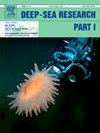New insights on the deep alkaline phosphatase paradox from a site in the Northeastern Pacific Ocean
IF 2.3
3区 地球科学
Q2 OCEANOGRAPHY
Deep-Sea Research Part I-Oceanographic Research Papers
Pub Date : 2024-11-20
DOI:10.1016/j.dsr.2024.104419
引用次数: 0
Abstract
Extracellular hydrolytic enzymes are the main tools for microorganisms to access and degrade organic matter in the ocean. We investigated potential activities of four hydrolytic enzymes (alkaline phosphatase, beta-glucosidase, leucine aminopeptidase, chitinase) in the water column and surficial sediments at a deepwater site in the Northeastern Pacific Ocean (water depth: 2658 m). Our goal was to investigate the potential role of (re-)suspended particles as a source for enzyme activities in subsurface waters. Alkaline phosphatase (AP) dominated hydrolytic activities in subsurface waters and in sediments, reaching up to two orders of magnitude higher rates compared with the other three enzymes. Peak AP activities in the center of the oxygen minimum zone and in bottom waters were decoupled from concentrations of inorganic phosphorous (Pi), a pattern known as the deep AP paradox. A weak correlation between AP and bacterial abundances indicated that a fraction of AP was physically detached from their source cells (i.e., cell-free enzymes) and associated with particles either from surface waters (marine snow) or resuspended from the seafloor. We estimated that cell-free AP activities, which are decoupled from nutritional needs and oxidative processes of their source cells, contribute about 2%–9% of regenerated Pi in the bathypelagic Northeastern Pacific Ocean. (Re-)suspended particles as a source of cell-free AP thus play an important yet understudied role in deep-ocean elemental cycles.
从东北太平洋的一个地点对深碱性磷酸酶悖论的新见解
胞外水解酶是微生物获取和降解海洋有机物的主要工具。我们研究了四种水解酶(碱性磷酸酶、β -葡萄糖苷酶、亮氨酸氨基肽酶和几丁质酶)在东北太平洋深水区(水深2658米)的水柱和表层沉积物中的潜在活性,目的是研究(再)悬浮颗粒作为地下水酶活性来源的潜在作用。碱性磷酸酶(AP)在地下水和沉积物中的水解活性占主导地位,比其他3种酶的水解活性高2个数量级。氧最小带中心和底部水域的峰值AP活动与无机磷(Pi)浓度解耦,这种模式被称为深部AP悖论。AP与细菌丰度之间的弱相关性表明,一部分AP与它们的源细胞(即无细胞酶)物理分离,并与来自地表水(海洋雪)或海底重悬浮的颗粒相关联。我们估计,在东北太平洋深海中,与来源细胞的营养需求和氧化过程分离的无细胞AP活性贡献了大约2%-9%的再生Pi。(Re-)悬浮颗粒作为无细胞AP的来源,在深海元素循环中发挥着重要的作用,但尚未得到充分的研究。
本文章由计算机程序翻译,如有差异,请以英文原文为准。
求助全文
约1分钟内获得全文
求助全文
来源期刊
CiteScore
4.60
自引率
4.20%
发文量
144
审稿时长
18.3 weeks
期刊介绍:
Deep-Sea Research Part I: Oceanographic Research Papers is devoted to the publication of the results of original scientific research, including theoretical work of evident oceanographic applicability; and the solution of instrumental or methodological problems with evidence of successful use. The journal is distinguished by its interdisciplinary nature and its breadth, covering the geological, physical, chemical and biological aspects of the ocean and its boundaries with the sea floor and the atmosphere. In addition to regular "Research Papers" and "Instruments and Methods" papers, briefer communications may be published as "Notes". Supplemental matter, such as extensive data tables or graphs and multimedia content, may be published as electronic appendices.

 求助内容:
求助内容: 应助结果提醒方式:
应助结果提醒方式:


